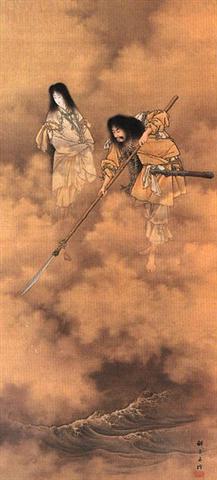|
3. Polyphemos was the son of Poseidon (the lord of Medusa) and presumably Poseidon took over when Sun had left. Instead of 'land' there was now 'sea' up in the sky. Allen: "The Almagest of 1515 already had Trica, describing it as nubilosa and luminosa; but Bayer changed this to Tricas, Tericas, and Triquetras, taking them possibly from the Low Greek τριχες, which doubtless is the origin of our word 'tresses' ... Thompson writes in his Glossary, p. 134, that It has been suggested by Landseer, Sabaean Researches, p. 186, from the study of an Assyrian symbolic monument, that the stars which Conon converted into the Coma Berenices ... and which lie in Leo opposite to the Pleiades in Taurus, were originally constellated as a Dove; and that this constellation, whose first stars rise with the latest of those in Argo, and whose last rise simultaneously with the hand of the Husbandsman, links better than the Pleiad into the astronomical Deluge-myth. The case rests on very little evidence, and indeed is an illustration of the conflicting difficulties of such hypotheses; but it is deserving of investigation, were it only for the reason that the Coma Berenices contains seven visible stars (Hygin.), and the Pleiad six, a faint hint at a possible explanation of the lost Pleiad." This makes us return to the poor Kuukuu, deadly stricken by the Turtle, then carried on a stretcher into a cave, and abandoned there by his 6 comrades. Never again can we see him in the pages of Manuscript E, he disappears without a trace as if swallowed by earth (like the tresses of Berenike). 6 men were eaten in the cave by Polyphemos, but outside the cave there were 6 stone heaps left standing (south of the equator the season was the opposite and 'inside' in the north becomes 'outside' in the south). Another person appears in due time to fill the place of Kuukuu and then the explorers were 7 again (cfr at Egyptian X): ... After naming the topographical features of Easter Island with names from their land of origin, the emissaries went from the west coast up to the rim of the crater Rano Kau, where Kuukuu had started a yam plantation some time earlier. After they had departed from Pu Pakakina they reached Vai Marama and met a man. Ira asked, 'How many are you?' He answered, 'There are two of us.' Ira continued asking, 'Where is he (the other)?' To that he answered, 'The one died.' Again Ira asked, 'Who has died?' He replied, 'That was Te Ohiro A Te Runu.' Ira asked anew, 'And who are your?' He answered, 'Nga Tavake A Te Rona.' (E:46) After this, the emissaries and Nga Tavake went to the yam plantation ... The following two pages in Manuscript E (pp. 47-48) have their bottom thirds cut off:
Perhaps this phenomenon is a Sign which indicates where the cycles of time are 'braided together' - where the 'knots' of course must 'swallow' a part of the threads, making them shorter. To unite man and woman sexual intercourse is the proper means: ... Old Norse askr literally means 'ash tree' but the etymology of embla is uncertain ... A Proto-Indo-European basis has been theorized for the duo based on the etymology of embla meaning 'vine'. In Indo-European societies, an analogy is derived from the drilling of fire and sexual intercourse. Vines were used as a flammable wood, where they were placed beneath a drill made of harder wood, resulting in fire ...
In this picture (from Wikipedia) we can see how the man (Izanagi) and his sister (Izanami) are creating the Japanese island of Onokoro: "The last couple of the seven generations of gods who appeared when heaven and earth began, Izanagi and Izanami, received the order to consolidate and fertilize the moving earth. Here Izanagi stirs the waters of the sea with his celestial lance to produce the island of Onokoro. The brother and sister then descended to it and engendered the islands of Japan and numerous deities. Silk painting, nineteenth century A.D." (New Larousse Encyclopedia of Mythology) In the mythology of Easter Island, I think, the sight of the 3 islets outside the southwestern corner of the island proper should remind (kai viri, kai viri) the voyager from abroad of the trident of Poseidon (the era before 'land' was created): "... Ms. A states that Te Taanga ... charged his three sons (Nga Tavake, Te Ohiro, and Hau) with the construction of a canoe. On the other hand we know that the three sons of Te Taanga were turned into the three islets off the southwestern cape of Easter Island and thus served as a landmark for all newcomers, including the dream soul of Hau Maka! Thus, the three sons of Te Taanga, who were lost during the exploratory journey, must belong to an earlier generation." (The Eighth Island) |
||||||||||||||||||||||||
